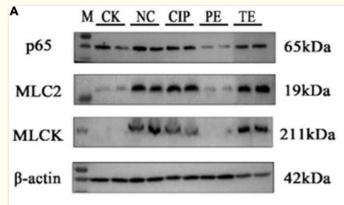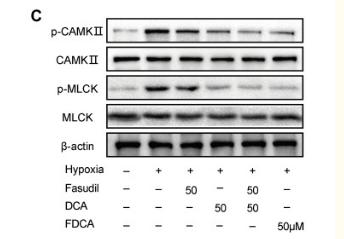MLCK Antibody - #AF5314
| Product: | MLCK Antibody |
| Catalog: | AF5314 |
| Description: | Rabbit polyclonal antibody to MLCK |
| Application: | WB |
| Reactivity: | Human, Mouse, Rat |
| Prediction: | Bovine, Sheep, Rabbit, Dog, Chicken |
| Mol.Wt.: | 211 kDa.; 211kD(Calculated). |
| Uniprot: | Q15746 |
| RRID: | AB_2837799 |
Related Downloads
Protocols
Product Info
*The optimal dilutions should be determined by the end user.
*Tips:
WB: For western blot detection of denatured protein samples. IHC: For immunohistochemical detection of paraffin sections (IHC-p) or frozen sections (IHC-f) of tissue samples. IF/ICC: For immunofluorescence detection of cell samples. ELISA(peptide): For ELISA detection of antigenic peptide.
Cite Format: Affinity Biosciences Cat# AF5314, RRID:AB_2837799.
Fold/Unfold
deglutamylated form; DKFZp686I10125; EC 2.7.11.18; FLJ12216; Kinase related protein; Kinase-related protein; KRP; MLCK; MLCK1; MLCK108; MLCK210; MSTP083; MYLK; MYLK_HUMAN; MYLK1; Myosin light chain kinase; Myosin light polypeptide kinase; OTTHUMP00000180642; OTTHUMP00000180643; smMLCK; smooth muscle; Smooth muscle myosin light chain kinase; Telokin;
Immunogens
Smooth muscle and non-muscle isozymes are expressed in a wide variety of adult and fetal tissues and in cultured endothelium with qualitative expression appearing to be neither tissue- nor development-specific. Non-muscle isoform 2 is the dominant splice variant expressed in various tissues. Telokin has been found in a wide variety of adult and fetal tissues. Accumulates in well differentiated enterocytes of the intestinal epithelium in response to tumor necrosis factor (TNF).
- Q15746 MYLK_HUMAN:
- Protein BLAST With
- NCBI/
- ExPASy/
- Uniprot
MGDVKLVASSHISKTSLSVDPSRVDSMPLTEAPAFILPPRNLCIKEGATAKFEGRVRGYPEPQVTWHRNGQPITSGGRFLLDCGIRGTFSLVIHAVHEEDRGKYTCEATNGSGARQVTVELTVEGSFAKQLGQPVVSKTLGDRFSAPAVETRPSIWGECPPKFATKLGRVVVKEGQMGRFSCKITGRPQPQVTWLKGNVPLQPSARVSVSEKNGMQVLEIHGVNQDDVGVYTCLVVNGSGKASMSAELSIQGLDSANRSFVRETKATNSDVRKEVTNVISKESKLDSLEAAAKSKNCSSPQRGGSPPWAANSQPQPPRESKLESCKDSPRTAPQTPVLQKTSSSITLQAARVQPEPRAPGLGVLSPSGEERKRPAPPRPATFPTRQPGLGSQDVVSKAANRRIPMEGQRDSAFPKFESKPQSQEVKENQTVKFRCEVSGIPKPEVAWFLEGTPVRRQEGSIEVYEDAGSHYLCLLKARTRDSGTYSCTASNAQGQLSCSWTLQVERLAVMEVAPSFSSVLKDCAVIEGQDFVLQCSVRGTPVPRITWLLNGQPIQYARSTCEAGVAELHIQDALPEDHGTYTCLAENALGQVSCSAWVTVHEKKSSRKSEYLLPVAPSKPTAPIFLQGLSDLKVMDGSQVTMTVQVSGNPPPEVIWLHNGNEIQESEDFHFEQRGTQHSLCIQEVFPEDTGTYTCEAWNSAGEVRTQAVLTVQEPHDGTQPWFISKPRSVTASLGQSVLISCAIAGDPFPTVHWLRDGKALCKDTGHFEVLQNEDVFTLVLKKVQPWHAGQYEILLKNRVGECSCQVSLMLQNSSARALPRGREPASCEDLCGGGVGADGGGSDRYGSLRPGWPARGQGWLEEEDGEDVRGVLKRRVETRQHTEEAIRQQEVEQLDFRDLLGKKVSTKTLSEDDLKEIPAEQMDFRANLQRQVKPKTVSEEERKVHSPQQVDFRSVLAKKGTSKTPVPEKVPPPKPATPDFRSVLGGKKKLPAENGSSSAETLNAKAVESSKPLSNAQPSGPLKPVGNAKPAETLKPMGNAKPAETLKPMGNAKPDENLKSASKEELKKDVKNDVNCKRGHAGTTDNEKRSESQGTAPAFKQKLQDVHVAEGKKLLLQCQVSSDPPATIIWTLNGKTLKTTKFIILSQEGSLCSVSIEKALPEDRGLYKCVAKNDAGQAECSCQVTVDDAPASENTKAPEMKSRRPKSSLPPVLGTESDATVKKKPAPKTPPKAAMPPQIIQFPEDQKVRAGESVELFGKVTGTQPITCTWMKFRKQIQESEHMKVENSENGSKLTILAARQEHCGCYTLLVENKLGSRQAQVNLTVVDKPDPPAGTPCASDIRSSSLTLSWYGSSYDGGSAVQSYSIEIWDSANKTWKELATCRSTSFNVQDLLPDHEYKFRVRAINVYGTSEPSQESELTTVGEKPEEPKDEVEVSDDDEKEPEVDYRTVTINTEQKVSDFYDIEERLGSGKFGQVFRLVEKKTRKVWAGKFFKAYSAKEKENIRQEISIMNCLHHPKLVQCVDAFEEKANIVMVLEIVSGGELFERIIDEDFELTERECIKYMRQISEGVEYIHKQGIVHLDLKPENIMCVNKTGTRIKLIDFGLARRLENAGSLKVLFGTPEFVAPEVINYEPIGYATDMWSIGVICYILVSGLSPFMGDNDNETLANVTSATWDFDDEAFDEISDDAKDFISNLLKKDMKNRLDCTQCLQHPWLMKDTKNMEAKKLSKDRMKKYMARRKWQKTGNAVRAIGRLSSMAMISGLSGRKSSTGSPTSPLNAEKLESEEDVSQAFLEAVAEEKPHVKPYFSKTIRDLEVVEGSAARFDCKIEGYPDPEVVWFKDDQSIRESRHFQIDYDEDGNCSLIISDVCGDDDAKYTCKAVNSLGEATCTAELIVETMEEGEGEGEEEEE
Predictions
Score>80(red) has high confidence and is suggested to be used for WB detection. *The prediction model is mainly based on the alignment of immunogen sequences, the results are for reference only, not as the basis of quality assurance.
High(score>80) Medium(80>score>50) Low(score<50) No confidence
PTMs - Q15746 As Substrate
| Site | PTM Type | Enzyme | Source |
|---|---|---|---|
| S13 | Phosphorylation | Uniprot | |
| S16 | Phosphorylation | Uniprot | |
| T88 | Phosphorylation | Uniprot | |
| Y104 | Phosphorylation | Uniprot | |
| T109 | Phosphorylation | Uniprot | |
| T118 | Phosphorylation | Uniprot | |
| S145 | Phosphorylation | Uniprot | |
| Y231 | Phosphorylation | P00519 (ABL1) | Uniprot |
| S287 | Phosphorylation | Uniprot | |
| S305 | Phosphorylation | Uniprot | |
| S324 | Phosphorylation | Uniprot | |
| S328 | Phosphorylation | Uniprot | |
| T331 | Phosphorylation | Uniprot | |
| T335 | Phosphorylation | Uniprot | |
| S343 | Phosphorylation | Uniprot | |
| S365 | Phosphorylation | Uniprot | |
| S367 | Phosphorylation | Uniprot | |
| S422 | Phosphorylation | Uniprot | |
| S460 | Phosphorylation | Uniprot | |
| Y464 | Phosphorylation | P00519 (ABL1) , P12931 (SRC) | Uniprot |
| S469 | Phosphorylation | Uniprot | |
| Y471 | Phosphorylation | P12931 (SRC) | Uniprot |
| T488 | Phosphorylation | Uniprot | |
| S515 | Phosphorylation | Uniprot | |
| Y556 | Phosphorylation | P00519 (ABL1) | Uniprot |
| K603 | Methylation | Uniprot | |
| K608 | Acetylation | Uniprot | |
| Y611 | Phosphorylation | P00519 (ABL1) | Uniprot |
| Y792 | Phosphorylation | P00519 (ABL1) | Uniprot |
| S827 | Phosphorylation | Uniprot | |
| Y846 | Phosphorylation | P00519 (ABL1) | Uniprot |
| S848 | Phosphorylation | Uniprot | |
| T883 | Phosphorylation | Uniprot | |
| S911 | Phosphorylation | Uniprot | |
| S947 | Phosphorylation | Uniprot | |
| T978 | Phosphorylation | Uniprot | |
| K1042 | Acetylation | Uniprot | |
| S1093 | Phosphorylation | Uniprot | |
| K1101 | Methylation | Uniprot | |
| K1103 | Methylation | Uniprot | |
| K1113 | Acetylation | Uniprot | |
| S1151 | Phosphorylation | Uniprot | |
| S1208 | Phosphorylation | Q13177 (PAK2) | Uniprot |
| S1209 | Phosphorylation | Uniprot | |
| T1230 | Phosphorylation | Uniprot | |
| Y1410 | Phosphorylation | Uniprot | |
| S1438 | Phosphorylation | Uniprot | |
| Y1449 | Phosphorylation | P00519 (ABL1) | Uniprot |
| K1496 | Acetylation | Uniprot | |
| Y1575 | Phosphorylation | P00519 (ABL1) | Uniprot |
| S1617 | Phosphorylation | Uniprot | |
| Y1635 | Phosphorylation | P00519 (ABL1) | Uniprot |
| K1744 | Acetylation | Uniprot | |
| K1747 | Acetylation | Uniprot | |
| T1748 | Phosphorylation | Q15746 (MYLK) | Uniprot |
| S1759 | Phosphorylation | Q13177 (PAK2) | Uniprot |
| S1760 | Phosphorylation | Q15746 (MYLK) | Uniprot |
| S1768 | Phosphorylation | Q15746 (MYLK) | Uniprot |
| S1772 | Phosphorylation | Q13153 (PAK1) | Uniprot |
| S1773 | Phosphorylation | P17612 (PRKACA) | Uniprot |
| T1774 | Phosphorylation | Uniprot | |
| S1776 | Phosphorylation | P49841 (GSK3B) | Uniprot |
| T1778 | Phosphorylation | Uniprot | |
| S1779 | Phosphorylation | P27361 (MAPK3) , P28482 (MAPK1) | Uniprot |
| S1788 | Phosphorylation | Uniprot | |
| S1793 | Phosphorylation | Uniprot | |
| S1824 | Phosphorylation | Uniprot | |
| Y1835 | Phosphorylation | Uniprot | |
| S1848 | Phosphorylation | Uniprot | |
| S1852 | Phosphorylation | Uniprot |
PTMs - Q15746 As Enzyme
| Substrate | Site | Source |
|---|---|---|
| O14950 (MYL12B) | T19 | Uniprot |
| O14950 (MYL12B) | S20 | Uniprot |
| P10916 (MYL2) | S15 | Uniprot |
| P24844 (MYL9) | T19 | Uniprot |
| P24844 (MYL9) | S20 | Uniprot |
| Q05682 (CALD1) | S73 | Uniprot |
| Q05682 (CALD1) | T666 | Uniprot |
| Q05682 (CALD1) | S700 | Uniprot |
| Q05682 (CALD1) | T735 | Uniprot |
| Q05682 (CALD1) | S744 | Uniprot |
| Q15746 (MYLK) | T1748 | Uniprot |
| Q15746 (MYLK) | S1760 | Uniprot |
| Q15746 (MYLK) | S1768 | Uniprot |
Research Backgrounds
Calcium/calmodulin-dependent myosin light chain kinase implicated in smooth muscle contraction via phosphorylation of myosin light chains (MLC). Also regulates actin-myosin interaction through a non-kinase activity. Phosphorylates PTK2B/PYK2 and myosin light-chains. Involved in the inflammatory response (e.g. apoptosis, vascular permeability, leukocyte diapedesis), cell motility and morphology, airway hyperreactivity and other activities relevant to asthma. Required for tonic airway smooth muscle contraction that is necessary for physiological and asthmatic airway resistance. Necessary for gastrointestinal motility. Implicated in the regulation of endothelial as well as vascular permeability, probably via the regulation of cytoskeletal rearrangements. In the nervous system it has been shown to control the growth initiation of astrocytic processes in culture and to participate in transmitter release at synapses formed between cultured sympathetic ganglion cells. Critical participant in signaling sequences that result in fibroblast apoptosis. Plays a role in the regulation of epithelial cell survival. Required for epithelial wound healing, especially during actomyosin ring contraction during purse-string wound closure. Mediates RhoA-dependent membrane blebbing. Triggers TRPC5 channel activity in a calcium-dependent signaling, by inducing its subcellular localization at the plasma membrane. Promotes cell migration (including tumor cells) and tumor metastasis. PTK2B/PYK2 activation by phosphorylation mediates ITGB2 activation and is thus essential to trigger neutrophil transmigration during acute lung injury (ALI). May regulate optic nerve head astrocyte migration. Probably involved in mitotic cytoskeletal regulation. Regulates tight junction probably by modulating ZO-1 exchange in the perijunctional actomyosin ring. Mediates burn-induced microvascular barrier injury; triggers endothelial contraction in the development of microvascular hyperpermeability by phosphorylating MLC. Essential for intestinal barrier dysfunction. Mediates Giardia spp.-mediated reduced epithelial barrier function during giardiasis intestinal infection via reorganization of cytoskeletal F-actin and tight junctional ZO-1. Necessary for hypotonicity-induced Ca(2+) entry and subsequent activation of volume-sensitive organic osmolyte/anion channels (VSOAC) in cervical cancer cells. Responsible for high proliferative ability of breast cancer cells through anti-apoptosis.
Can probably be down-regulated by phosphorylation. Tyrosine phosphorylation by ABL1 increases kinase activity, reverses MLCK-mediated inhibition of Arp2/3-mediated actin polymerization, and enhances CTTN-binding. Phosphorylation by SRC at Tyr-464 and Tyr-471 promotes CTTN binding.
The C-terminus is deglutamylated by AGTPBP1/CCP1, AGBL1/CCP4 and AGBL4/CCP6, leading to the formation of Myosin light chain kinase, smooth muscle, deglutamylated form. The consequences of C-terminal deglutamylation are unknown (By similarity).
Acetylated at Lys-608 by NAA10/ARD1 via a calcium-dependent signaling; this acetylation represses kinase activity and reduces tumor cell migration.
Cytoplasm. Cell projection>Lamellipodium. Cleavage furrow. Cytoplasm>Cytoskeleton>Stress fiber.
Note: Localized to stress fibers during interphase and to the cleavage furrow during mitosis.
Smooth muscle and non-muscle isozymes are expressed in a wide variety of adult and fetal tissues and in cultured endothelium with qualitative expression appearing to be neither tissue- nor development-specific. Non-muscle isoform 2 is the dominant splice variant expressed in various tissues. Telokin has been found in a wide variety of adult and fetal tissues. Accumulates in well differentiated enterocytes of the intestinal epithelium in response to tumor necrosis factor (TNF).
All isoforms including Telokin bind calmodulin. Interacts with SVIL (By similarity). Interacts with CTTN; this interaction is reduced during thrombin-induced endothelial cell (EC) contraction but is promoted by the barrier-protective agonist sphingosine 1-phosphate (S1P) within lamellipodia. A complex made of ABL1, CTTN and MYLK regulates cortical actin-based cytoskeletal rearrangement critical to sphingosine 1-phosphate (S1P)-mediated endothelial cell (EC) barrier enhancement. Binds to NAA10/ARD1 and PTK2B/PYK2.
Belongs to the protein kinase superfamily. CAMK Ser/Thr protein kinase family.
Research Fields
· Cellular Processes > Cellular community - eukaryotes > Focal adhesion. (View pathway)
· Cellular Processes > Cell motility > Regulation of actin cytoskeleton. (View pathway)
· Environmental Information Processing > Signal transduction > Calcium signaling pathway. (View pathway)
· Environmental Information Processing > Signal transduction > cGMP-PKG signaling pathway. (View pathway)
· Environmental Information Processing > Signal transduction > Apelin signaling pathway. (View pathway)
· Organismal Systems > Circulatory system > Vascular smooth muscle contraction. (View pathway)
· Organismal Systems > Immune system > Platelet activation. (View pathway)
· Organismal Systems > Endocrine system > Oxytocin signaling pathway.
· Organismal Systems > Digestive system > Gastric acid secretion.
References
Application: WB Species: Mouse Sample:
Application: WB Species: Human Sample: pulmonary arterial smooth muscle cell
Restrictive clause
Affinity Biosciences tests all products strictly. Citations are provided as a resource for additional applications that have not been validated by Affinity Biosciences. Please choose the appropriate format for each application and consult Materials and Methods sections for additional details about the use of any product in these publications.
For Research Use Only.
Not for use in diagnostic or therapeutic procedures. Not for resale. Not for distribution without written consent. Affinity Biosciences will not be held responsible for patent infringement or other violations that may occur with the use of our products. Affinity Biosciences, Affinity Biosciences Logo and all other trademarks are the property of Affinity Biosciences LTD.


